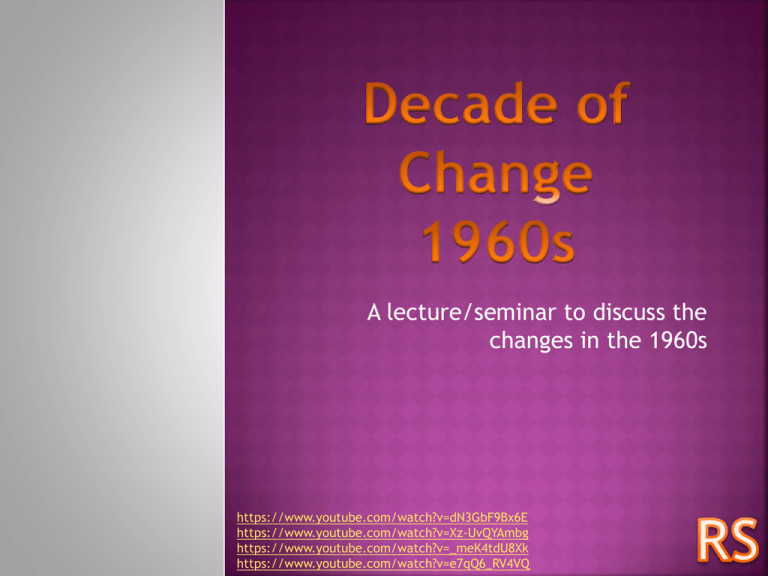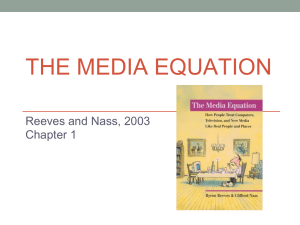Decade of Change 1960s Main Pres and Tasks
advertisement

A lecture/seminar to discuss the changes in the 1960s https://www.youtube.com/watch?v=dN3GbF9Bx6E https://www.youtube.com/watch?v=Xz-UvQYAmbg https://www.youtube.com/watch?v=_meK4tdU8Xk https://www.youtube.com/watch?v=e7qQ6_RV4VQ Material Culture Analysis Art, Philosophy and Aesthetics Principles in Aesthetics - The ideal i.e. Beauty, Taste, Truth, Morality, Judgement, Pleasure and Un-pleasure David Jules Prown’s Method outlined in ‘Mind and Matter. An Introduction to Material Culture and Methodology (1982) 3 Stages - Description, Deduction and Speculation Areas to be covered: The Decade of Change 1960s Aim: To understand why design matters from the changes within the 60s Learning Outcomes: By the end of this lecture, you will be able to identify key movements and the effect it had on design. How people reacted to the changes of the 1960s decade. How? What Happened? When? Why? Who? Many people look back on the 60's and purely see drugs, war, and social descent, but it was a period that represented so much more. The 60's was a time of the peace movement, social rebellion and the quest for freedom of expression. The 60's had it's own style that still often appears in todays fashions. http://www.theguardian.com/film/gallery/2009/jan/2 3/nixon-on-film http://cdn.straightfromthea.com/wp-content/uploads/2011/01/alg_freedom-mlk.jpg http://en.wikipedia.org/wiki/File:Lyndon_B._J ohnson_-_Official_White_House_Portrait.jpg https://artsenglish.wikispaces.com/Vimee+Motown https://www.pinterest.com/pin/444871269415481310/ It symbolized a new day: its energetic product reflected the striving toward progress and optimism of a longoppressed people and the nation as a whole. ‘The Sound of Young America’. In February 1965, the Vietcong attacked American air bases and killed American soldiers. President Johnson declared war against North Vietnam. In 1962 the Cuban Missile Crisis was a part of the Cold War. Cuba and Russia are communist countries. Therefore Russia decided to set up nuclear bomb aimed at America. https://cherrieswriter.files.wordpress.com/2012/11/p25.jpg Nikita Khrushchev Che Guevara http://www.aptv.org/ulphoto/wpt_1347484968.jpg Kennedy Legacy of the 60’s has been important for the development of society and culture in Britain Rediscovery It of poverty was marked by pop music, rockers, flower power, the Vietnam war and the Campaign for Nuclear Disarmament 1957: Britons 'have never had it so good' The British Prime Minister, Harold Macmillan, has made an optimistic speech telling fellow Conservatives that "most of our people have never had it so good". Macmillan painted a picture of Britain's economy while urging wage restraint and warning inflation was the country's most important problem of the post-war era. Harold Macmillan bought down the rate of income tax by almost a shilling in the pound in the budget of 1959. Key features of the new era • • http://news.bbc.co.uk/onthisday/hi/dates/stories/july/20/ne wsid_3728000/3728225.stm He reminded his audience not to forget "rationing, shortages, inflation, and one crisis after another in our international trade" under a Labour government. Increased production in major industries such as steel, coal and motor cars had led to a rise in wages, export earnings and investment • • http://img.dooyoo.co.uk/GB_EN/orig/0/1/6/3/4/163411. jpg Critique of the ‘Establishment’. The beginnings of the working class rise to careers in the theatre and BBC, publication and the Design Industry. Encouragement of more people into University , Teaching and other sorts of training. Period of economic growth and leadership in manufacture. http://www.the59clubla.com/?author=1&paged=10 http://www.stthomasu.ca/~pmccorm/modsandrockers3.html During the 1960s the look evolved and many Teddy boys turned in to rockers or more insultingly, "greasers". As the effect of post-World War II rationing lessened there was increased affluence; young people could buy motorbikes and were heavily influenced by the influx of music and film from America. http://imgarcade.com/1/the-rockers-1960s/ http://www.3quarksdaily.com It became a British youth subculture movement. It was focused on fashion and music. This where young people dressed in "modern" ways that were not common at the time. As mod teens and young adults began using their disposable income to buy stylish clothes, the first youth-targeted boutique clothing stores opened in London in the Carnaby Street and King's Road districts. www.pinterest.com http://www.viceland.com/wp/wp-content/uploads/2010/09/mods-vs-rockers.jpg The fashion war of the 60’s was between the Mods (neat dress/Italian scooters) and Rockers (leather gear/roaring bikers) in Britain. They fought each other on the beaches at Hastings on August Bank Holiday 1964 The Mod revolution enabled working class youths with disposable incomes (working in a bank or a shop) to wear sharp Italian suits with narrow lapels and to take their street identity into the working environment. The film Quadrophenia was made in 1979 and is filmed around the weekend in August 1964 in Hastings and celebrates some of the style and music of the period. Lambretta was a line of motor scooters originally manufactured in Milan, Italy, by Innocenti. Vespas were a Italian brand and had their largest global market in the 60’s. The appeal of the Vespa to the styleconscious mods was the fuel efficiency and the weather protection. Their counterparts, the rockers rode classic British motorcycles and needed to wear leathers against the elements. Lambretta was an iconic vehicle of the 1960s when they became the adopted vehicle of choice for the UK youth-culture known as Mods. http://www.lauramacij.com/2014/09/1960s-fever.html Mods would modify their Vespas, adding lights, mascots, accessories, various racks and crash bars. A new lifestyle evolved in the UK, with thousands attending scooter rallies. It was the golden age for style gurus. Rapidly rising through fame through the medium of boutique or salon. John Stephan outside The MOD MALE shop catering for suit and scooter clientele in July 1964. Two of the biggest names in Swinging London fashion… Vidal Sassoon gives Mary Quant a cut. Harold Wilson presenting the Show Business of the Year awards to the Beatles in 1964. After 13 years in opposition, the Labour Party gained power in the 1964 British General Election, promoting the image of being in touch with modern times. Backed by their manager Brian Epstein, The Beetles invaded the states in 1946. Writers, artists, and performers all became involved in the rising Western culture of protest. Folk singers took the lead, among them. Dylan’s The Times They Are aChangin’ became an anthem of protest. Carnaby Street and the Kings Road. https://www.youtube.co m/watch?v=tBq7icqGxB4 ‘There really was a vacuum in those days. There was simply nothing for young people. The older generation were dying to revert to pre-war ways, but… we wanted to go forward, to do something new. The art schools were the great forcing house of talent not just clothes but music….design, food, lifestyle, politics and everything’. Mary Quant in Gardiner J (1999) from the bomb to the beatles: the changing face of post-war Britain 1945 -1965, London, Collins and Brown p134 http://www.google.co.uk/search?aq=&rlz=1T4ADRA _enGB488GB488&q=paco%20rabanne%201960s http://www.google.co.uk/search?rl z=1T4ADRA_enGB488GB488&q=Mary %20Quant%201960s A boutique called Granny Takes a Trip had opened its doors in December 1965. Behind the boutique were graphic designer Nigel Weymouth and his girlfriend Sheila Cohen. Her collection constituted a large part of early stock at Granny's - mostly second hand Victoriana and oriental garments. Garments had to be either colourful or unusual or both. The name of the boutique was giving away its policy - 'Granny' symbolized the influence of the past, and 'Trip' , a colourful world of the rapidly growing hippie movement and its drug of choice - LSD Probably the most iconic garment made by Granny Takes a Trip - William Morris chrysantenum print jacket as worn by John Lennon George Harrison wearing William Morris Golden Lily pattern jacket from GTAT, 1967 http://dandyinaspic.blogspot.co.uk/2011/07/granny-takes-trip.html Granny Takes a Trip jacket from 1967. It is made of William Morris 'bachelor's button' pattern, which was first produced by Morris & Co. in 1892. http://static.guim.co.uk/sysimages/Arts/Arts_/Pictures/2009/8/18/1250584019928/BlazeStudy-1962-by-Bridg-005.jpg http://www.standard.co.uk/lifestyle/article6467688.ece/ALT ERNATES/w460/bridget+riley Foale and Tuffin used Op Art influences along with Mary Quant. http://2.bp.blogspot.com/yeUXPaeu0f0/TmO0PeioDXI/AAAAAAAAAhA/MisGhG7Sx2w/s1600/1.j pg Edie Sedgwick Known as Andy Warhol’s superstar http://www.lauramacij.com/2014/09/1960s-fever.html Julie Newmar actress • Big earings • Pale lipstick • Heavy eye makeup 1960s Furniture Design. Furniture design in the 1960s developed from new techniques including injection moulded plastic, polycarbonates, fibre glass, water filled plastics. It was bright, colourful, space saving (as in the Robin Day chairs above) or statement making like Eero Aarnios’s Ball Chair (above right). It was also playful and child like. Levels of chairs and seating were much lower and closer to the ground. The interior space was for fun and pleasure. Domestic microwave ovens were cutting edge technology in the swinging sixties. Biba was established by Barbara Hulanicki in 1964 as small catalogue business for young girls in Kensington. She then established a shop and later moved into the old Derry and Tom’s department store in High Street, Kensington – where the original Art Deco features of the building were incorporated into her graphics and shop fitting as well as part of the package design. An iconic 60s fashion retail outlet this lasted until the 1970s. http://www.american-buddha.com/a-acid21.jpg Flower power and the hippie movement at large in the United States reached in 1967, with a march on the Pentagon. More than 100,000 people gathered in Washington D.C. for that peaceful Vietnam War protest Celia Birtwell Zandra Rhodes Celia Birtwell and Zandra Rhodes were both significant designers of the late 1960s. They used textile screen printing techniques to create their fabrics. Zandra Rhodes then allowed the fabric print to dictate the shape of the final garment. Celia Birtwell formed a partnership with Fashion Designer Ossie Clark who reintroduced the bias cut of the1930s with soft crepe fabrics with contemporary motifs. Both designers used the flowing unstructured styles of the hippies to inform their collections. http://i.telegraph.co.uk/multimedia/archive/02321/the-beatles_2321270b.jpg http://a.abcnews.go.com http://www.pophistorydig.com





